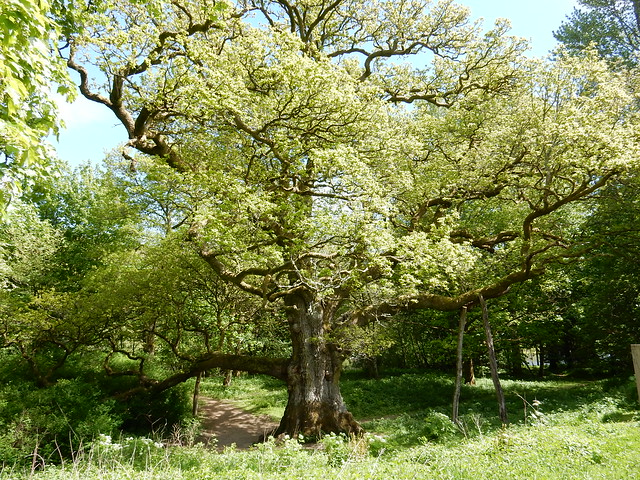35億年前,地球的生命開始後,現今地球上的各種生物皆從其他生物演化而來。許多年來,學術界陸續發表了數以萬計物種的數位資源,成為地球「生命之樹」的分枝,有的分枝甚至包含10萬種以上的物種。而科學家首次將這些分枝整合成一棵完整的生命之樹,開放給所有人下載、使用。
涵蓋230萬筆物種資料的生命之樹。圖片來源:英國杜克大學(Duke University)。
生命之樹初具雛形 開放資料供全民下載
生命之樹的數位資源18日發表於國家科學院院刊,現在已經放上網路,開放所有人使用與共同編輯,就像是演化的維基百科。目前的版本以及其中的資料和程式碼,民眾都可以點選網址https://tree.opentreeoflife.org瀏覽和下載。
這棵生命之樹由11個國際研究機構合作,共包含230萬個物種,包括動物、植物、真菌和微生物,但參與的科學家認為,這棵樹距離完整還差得遠。杜克大學首席研究員Karen Cranston表示:「這是學界首次嘗試將所有的點連接起來,可把它想成是版本1.0。」
密西根大學演化生物學家Stephen Smith的團隊負責連接所有分枝和樹幹。Smith說,將這484棵小樹結合成大樹是個艱苦的過程,共花了3年時間。
和Smith同為第一作者的愛達荷大學學者Cody Hinchliff表示:「許多參與的研究人員貢獻了數百小時從文獻中追溯和整理數千個分支,挑出484個來產生生命之樹的草稿。」
數百萬新物種待命名 生命之樹將繼續長大
「這棵樹不但顯示了我們對物種關係的認識,也反映了我們仍有所不知。25年前,人們認為不可能整理出這樣一棵生命之樹。但現在,這棵樹對其他研究人員來說是重要的起點,接下來幾十年,研究人員可以此為修改、精進的依據。」共同作者、佛羅里達大學學者Douglas Soltis說道。
除此之外,生命之樹能幫助我們瞭解地球上的數百萬種物種如何彼此相關,幫助科學家發現新藥、增加作物和畜牧收成,以及追溯HIV、伊波拉和流感等傳染病來源與散佈途徑。
為了繼續填滿這棵樹,研究團隊正在開發一套軟體,讓研究人員有了新的資料後,可以登入更新和修改生命之樹,畢竟現在地球上還有數百萬物種有待命名與發現。
「這絕不會是終點。分享已發表資料和新發表研究,對於讓樹持續成長至關重要。」Cranston說。
分布於英國蘇格蘭等地的古老無梗花櫟樹。攝影:。圖片來源:Beth M527。(CC BY-NC 2.0)
The relationships among living things, as they diverged from one another from the beginning of life on Earth more than 3.5 billion years ago, are shown for the first time in a comprehensive Tree of Life.
Tens of thousands of smaller trees of life have been published over the years for select branches of the tree, some containing more than 100,000 species, but this is the first time those results have been combined into a single tree that attempts to encompass all forms of life.
A collaborative effort among 11 institutions, the Tree of Life includes roughly 2.3 million named species of animals, plants, fungi and microbes – and it is far from complete, say the scientists who worked on the project.
The digital resource was published on Friday in the journal “Proceedings of the National Academy of Sciences.” It is now available free online for anyone to use or edit, something like a Wikipedia for evolutionary trees.
“This is the first real attempt to connect the dots and put it all together,” said principal investigator Karen Cranston of Duke University in Durham. “Think of it as Version 1.0.”
University of Michigan evolutionary biologist Stephen Smith heads the group that pieced together all the existing branches, stems and twigs of life's tree into a single diagram.
Cody Hinchliff, formerly a postdoctoral researcher in Smith's lab who is now at the University of Idaho, shares first-author credits with Smith on the PNAS paper.
“Many participants on the project contributed hundreds of hours tracking down and cleaning up thousands of trees from the literature, then selecting 484 of them that were used to generate the draft tree of life,” Hinchliff said.
Combining the 484 trees was a painstaking process that took three years to complete, said Smith, an assistant professor in the U. Mich. Department of Ecology and Evolutionary Biology.
Understanding how the millions of species on Earth are related to one another helps scientists discover new drugs, increase crop and livestock yields, and trace the origins and spread of infectious diseases such as HIV, Ebola and influenza.
“As important as showing what we do know about relationships, this first tree of life is also important in revealing what we don't know,” said co-author Douglas Soltis of the University of Florida.
“Twenty five years ago, people said this goal of huge trees was impossible,” Soltis said. “The Open Tree of Life is an important starting point that other investigators can now refine and improve for decades to come.”
The current version of the tree – along with the underlying data and source code – is available to browse and download at: https://tree.opentreeoflife.org.
To help fill in the gaps, the team is developing software that will allow researchers to log on and update and revise the tree as new data come in for the millions of species still being named or discovered.
“It's by no means finished,” Cranston said. “It's critically important to share data for already-published and newly-published work if we want to improve the tree.”
※ 全文及圖片詳見:ENS










